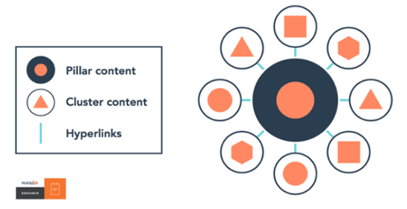
Content strategy is becoming more and more important, but how can we get good content that also gives us good SEO positioning? A pillar page can help you with this.
It's important to know that Google algorithm is not static, so you must be up to date with the SEO modifications that occur. Until recently, content marketing based its positioning on keywords, but new trends have started to appear. 64% of current searches are more than four words. When searching for information about schools in Madrid, we used to write "best schools Madrid", now we do it more completely: "what are the best schools in Madrid?".
These changes have led to algorithms such as those produced in recent years (Hummingbird, for example), which indicate the direction that all modifications are following: interpretation by context.This is known as semantic searches and it's here where the pillar pages take on great importance.
First, what is a Pillar Page?
A pillar page is a web page where we want to position a generic topic. In the case of mbudo, Inbound Marketing would be the main theme of our pillar page. This page is going to be the base of all related content. The additional content we will generate must have a direct relationship with our main theme, although it must make sense on its own too. To understand how a pillar page works, you have to take into account several concepts:
To start, you have to know what a Topic Cluster is; this refers to how website content is inter-related and linked to a main theme (how they are structured). This model will organize and link URLs together to make your pages rank higher on search engines. This structure is made up of three components: pillar content, cluster content and hyperlinks.

Source: HubSpot
These components help the pages to better position themselves and to give better answers to people.
For example, imagine that our Pillar is a bookshelf with books placed in no order; the topic cluster would organize them by topic, genre, author, etc. giving a structure and order to the bookstore.
The main objectives of a topic cluster are:
- Improve search engine visibility of topics that are strategic for your brand
- Improve the architecture and structure of your website
- Allow search engines and users to find other related content more easily
- Take advantage of the momentum that the rest of the topics will have if one of them is successful.
The next concept that is important for you to understand the whole set is Core Topic. This is the main topic around which the topic cluster will be organized; It will be a generic term of no more than two or three words and that will have a high number of searches and an interest for the brand. In the case of the subtopics, they'll be more specific and will have a lower number of both competition and searches.
How do you create Pillar Pages?
You have to think about which topics you want to be in the first positions and then brainstorm these for blogs, based on specific keywords and that are related to the main topic.
You can't forget the main interests of your Buyer Personas. Choose a topic that is broad enough to be able to create more blogs based on it, but it can't be too broad (you have to be able to cover it in a single web page).
Your Pillar Pages should answer any question someone has and should be linked to other pages or blogs that have more specific content on the topic searched.
Pillar Page Examples and Strategies: HubSpot and Typeform
HubSpot is one of the best platforms for generating all kinds of content, including pillar pages. Let's see an example of a HubSpot pillar page and get to know a little more about their strategies.
In this case, we will take their pillar page "the best productivity apps".
 To start, HubSpot chose this topic because it's covers the most common doubts generated by its public. This pillar page has the same appearance as their blogs: it has a characteristic image, a title with a certain shape and a domain like those used in blogs (blog.hubspot.com). Thanks to this, Google can see that there is an existing connection between the HubSpot pillar page and the blogs it links to.
To start, HubSpot chose this topic because it's covers the most common doubts generated by its public. This pillar page has the same appearance as their blogs: it has a characteristic image, a title with a certain shape and a domain like those used in blogs (blog.hubspot.com). Thanks to this, Google can see that there is an existing connection between the HubSpot pillar page and the blogs it links to.
In addition to this, HubSpot also has a very good internal linking strategy. They use CTAs so visitors can download content that is directly related to what they are reading. They also link their social networks to the pillar page and have a “Related articles” section (which are part of the cluster content of this pillar page) to create a group feeling and strengthen the pillar.
In the case of the Typeform brand, its pillar page is difficult to ignore. Not only is it aesthetically pleasing (thanks to the palette of relaxing and vivid colors they use) but it's also very easy to navigate.
In their use of internal links, they stand out for how they use CTAs so that people, with just a click, can directly get an offer that they saw on social media.
In addition, their strategy is not to link their pillars to meaningless content of their own; they just do it to help readers to find the solution they're looking for.
If you are thinking of creating your own Pillar Page and you don't know how, mbudo can help you or even take charge of your entire Content Marketing strategy. Don't hesitate to contact us, we would be happy to help you.

Alexandra Martín
Alexandra is a true Marketing enthusiast. Her aspirations inspired her to leave her native home in the Canary Islands and move to Madrid. She enjoys all the great cultural and professional offerings that this city holds. Alexandra also loves the sea, her dogs, and music.
It may interest you
LATEST
BLOG POSTS
SUBSCRIBE TO MBUDO BLOG
And get your inbound news directly in
your inbox, once a month.



